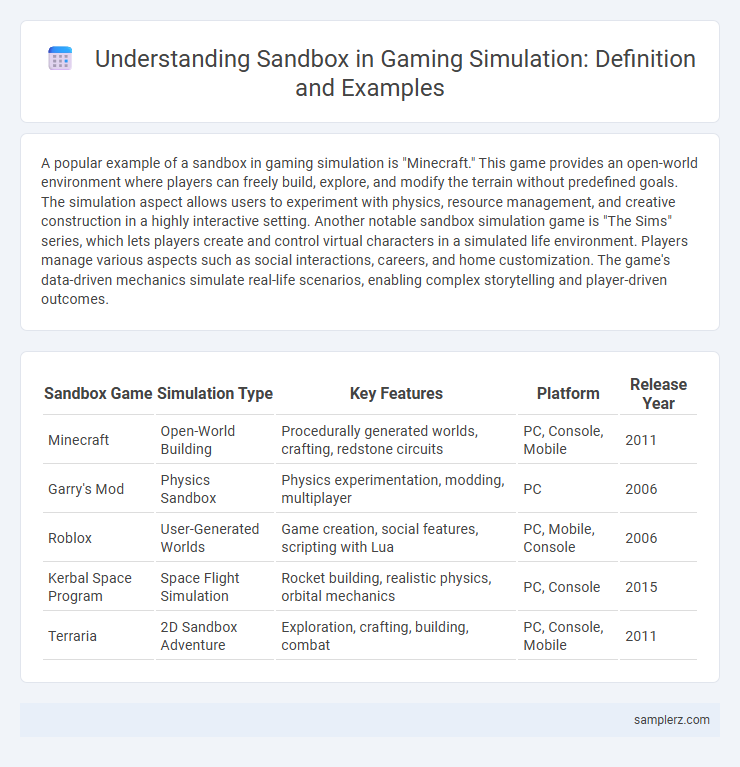A popular example of a sandbox in gaming simulation is "Minecraft." This game provides an open-world environment where players can freely build, explore, and modify the terrain without predefined goals. The simulation aspect allows users to experiment with physics, resource management, and creative construction in a highly interactive setting. Another notable sandbox simulation game is "The Sims" series, which lets players create and control virtual characters in a simulated life environment. Players manage various aspects such as social interactions, careers, and home customization. The game's data-driven mechanics simulate real-life scenarios, enabling complex storytelling and player-driven outcomes.
Table of Comparison
| Sandbox Game | Simulation Type | Key Features | Platform | Release Year |
|---|---|---|---|---|
| Minecraft | Open-World Building | Procedurally generated worlds, crafting, redstone circuits | PC, Console, Mobile | 2011 |
| Garry's Mod | Physics Sandbox | Physics experimentation, modding, multiplayer | PC | 2006 |
| Roblox | User-Generated Worlds | Game creation, social features, scripting with Lua | PC, Mobile, Console | 2006 |
| Kerbal Space Program | Space Flight Simulation | Rocket building, realistic physics, orbital mechanics | PC, Console | 2015 |
| Terraria | 2D Sandbox Adventure | Exploration, crafting, building, combat | PC, Console, Mobile | 2011 |
Defining Sandbox in Simulation Gaming
Sandbox in simulation gaming refers to an open-ended environment where players have full freedom to manipulate the game world without predefined objectives or linear constraints. Popular examples include games like Minecraft and The Sims, which allow users to build, modify, and experiment within expansive virtual spaces. This design encourages creativity, emergent gameplay, and personalized experiences, distinguishing sandbox simulations from traditional goal-oriented games.
Core Mechanics of Sandbox Simulation Games
Core mechanics of sandbox simulation games include open-ended world exploration, resource gathering, and player-driven construction. Players interact with dynamic environments that respond to actions such as building, crafting, and modifying terrain, fostering creativity and strategic decision-making. These mechanics enable emergent gameplay, where creativity and experimentation drive unique experiences without predefined objectives.
Notable Sandbox Simulation Game Titles
Minecraft stands as one of the most recognizable sandbox simulation games, offering players the freedom to build and explore procedurally generated worlds with limitless creativity. The Sims series also exemplifies sandbox simulation, allowing players to control the lives and environments of virtual characters in richly detailed neighborhoods. Another notable title, Garry's Mod, provides an open-ended physics sandbox where users can manipulate objects and create custom game modes, enhancing the simulation experience.
Open-Ended Gameplay Elements
Sandbox games like Minecraft exemplify open-ended gameplay elements by allowing players to create, modify, and interact with vast virtual worlds without predefined goals. Simulation titles such as The Sims provide players with complete freedom to design characters, build environments, and control daily activities, fostering creativity and emergent storytelling. This open-ended approach encourages exploration, experimentation, and player-driven narratives within unlimited gameplay possibilities.
Player-Created Content and Modding
Sandbox simulation games like Minecraft and Garry's Mod exemplify player-created content by offering extensive modding tools and open-world environments that empower users to build, customize, and share unique gameplay experiences. These platforms support robust modding communities where players develop new game modes, assets, and mechanics, significantly extending the lifespan and diversity of the game. User-generated content and modifications drive continuous innovation and engagement, making sandbox simulations a dynamic space for creativity in gaming.
Realism and Freedom in Simulation Sandboxes
Simulation sandboxes like "Minecraft" and "Kerbal Space Program" exemplify realism and freedom by providing players with detailed physics engines and open-ended gameplay. These games enable users to manipulate environments and mechanics extensively, fostering creativity and experimentation without predefined goals. The emphasis on realistic interactions and unrestricted player choice enhances immersion and personalized simulation experiences.
AI and Procedural Generation in Sandbox Worlds
Sandbox games like Minecraft and No Man's Sky use advanced AI to dynamically adapt NPC behavior, creating immersive and unpredictable environments. Procedural generation algorithms generate vast, diverse terrains and ecosystems, enabling unique player experiences in every session. This combination of AI and procedural content drives emergent gameplay and exploration in sandbox simulation worlds.
Community-Driven Sandbox Experiences
Community-driven sandbox experiences in gaming, such as Minecraft and Garry's Mod, empower players to create, modify, and share custom content within vast open worlds. These platforms foster collaborative creativity by offering flexible tools that accommodate diverse gameplay styles and user-generated modifications. Active player communities continually expand the game's possibilities through shared creations, resulting in dynamic and evolving simulation environments.
Educational Applications of Sandbox Simulations
Sandbox simulations in gaming, like Minecraft: Education Edition, provide immersive environments where students explore complex scientific concepts and historical events through interactive learning. Platforms such as SimCityEDU enable learners to experiment with urban planning and environmental management, fostering critical thinking and problem-solving skills. These educational applications leverage sandbox mechanics to create engaging, hands-on experiences that promote collaboration and creativity.
Future Trends in Sandbox Simulation Games
Sandbox simulation games are evolving with the integration of AI-driven procedural generation, enabling more dynamic and personalized game worlds. Virtual reality (VR) and augmented reality (AR) technologies are transforming player immersion by offering interactive, multisensory environments. Cloud gaming advancements facilitate seamless large-scale multiplayer experiences, fostering expansive, persistent sandbox universes.

example of sandbox in simulation Infographic
 samplerz.com
samplerz.com